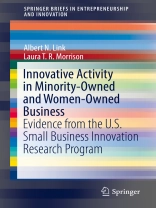This volume examines the involvement of minority- or women-owned businesses in technology-based research, with particular focus on the differences in research outcomes in achieving commercialization. Specifically, the authors empirically investigate the correlation between technologies from projects funded through the Phase II Small Business Innovation Research (SBIR) program and the minority or gender demographics of the owners of the businesses conducting the research. This study offers an opportunity to not only examine public-sector agencies’ investments in research, but also to investigate if there are race and/or gender gaps in such business’ participation in innovative activities. It also provides a means to understand innovation by minorities and women in the entrepreneurial ecosystem.
Investments in fundamental science and technology research and investments in human capital through science, technology, engineering, and mathematics (STEM) education areimportant building blocks of innovation. Two methods of fueling innovation are to 1) accelerate the commercialization of federally funded research and 2) ensure opportunities for underrepresented minorities and women in the entrepreneurial ecosystem. Despite this understanding, there is still a disparity in the rates of educated men and women in STEM fields participating in entrepreneurship. Moreover, the link between underrepresentation of minorities and women across STEM fields correlates with entrepreneurial entry and performance. This book expands on these findings and estimates the probability that (1) a funded research project reaches completion, (2) the developed technology is commercialized, and finally (3) the commercialized technology is successful in the marketplace (i.e., the business gained revenue and market share from the technology).
Innehållsförteckning
Chapter 1. Introduction.- Chapter 2. Background Literature Review.- Chapter 3. The U.S Small Business Innovation Research Program.- Chapter 4. The 2005 National Research Council Database.- Chapter 5. Innovative Activity in Minority-Owned and Women-Owned Businesses.- Chapter 6. Estimating the Probability of a Phase II Project being Discontinued.- Chapter 7. Estimating the Probability of Commercialization.- Chapter 8. Estimating the Success of Commercialization.- Chapter 9. Estimating Covariates the Knowledge Spillovers.- Chapter 10. Concluding Remarks.
Om författaren
Albert N. Link is the Virginia Batte Phillips Distinguished Professor at the University of North Carolina at Greensboro. Over the past several decades he has distinguished himself as a leading scholar in fields related to entrepreneurship, technology and innovation policy, technology transfer, and program evaluation. He is Editor-in-Chief of the Journal of Technology Transfer, and the founder and Editor of Annals of Science and Technology Policy. Dr. Link is a noted advisor to U.S. and international government agencies. Most recently, he has consulted for the U.S. Department of Energy, NASA, and the National Institute of Standards and Technology, as well as for the National Academy of Sciences, the Canadian government, and The World Bank. From 2007-2012 Link served as the U.S. Representative to the United Nations (Geneva) in the capacity of co-vice chairperson of the Team of Specialists on Innovation and Competitiveness Policies Initiative. In 2018, Link delivered the European Commission Distinguished Scholar Lecture at the Commission’s Joint Research Center (Seville).
Laura R. T. Morrison is a Research Economist at RTI International. She holds an M.P.P. (Public Policy) from Duke University. Her research focuses on the intersection of economics and technology among women, minority, and economically-disadvantaged populations in the United States and internationally. Her research includes studies on minority and women entrepreneurs and commercialization behaviors for the U.S. Small Business Administration and the National Women’s Business Council and evaluations of programs designed to improve minority and women business owners’ access to capital and public contracting opportunities in the United States.












